Below are featured the wheeled undercarriage (also called landing gear) arrangements of some modern commercial jet airliners and large military aircraft.
Below are featured the wheeled undercarriage (also called landing gear) arrangements of some modern commercial jet airliners and large military aircraft.
This table shows the main types of individual, basic wheeled units (single-wheel unit or bogies composed of multiple wheels) used on most aircraft undercarriages.
| Symbol | Wheeled unit | Example |
|---|---|---|
| | 2 wheels, 1 axle |  |
| | 4 wheels, 2 axles |  |
| | 6 wheels, 3 axles | 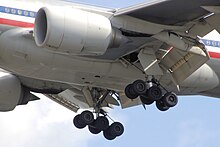 |
| | 14 wheels, 7 axles | 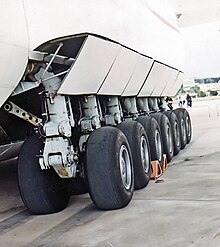 |
The tables below show how various types of wheeled units are arranged to form the undercarriages of some popular aircraft from manufacturers Antonov, Airbus, and Boeing.
| Aircraft | Wheels and Configuration | Nose section | Center section | Example |
|---|---|---|---|---|
| An-225 | 32 wheels [2x2]+[2x14] |  |  |  |
| Aircraft | Wheels and Configuration | Nose section | Center section | Example |
|---|---|---|---|---|
| A318, A319, A320 , A321(standard) | 6 wheels [1x2]+[2x2] |  |  |  |
| A300 , A310 , A320 , A330 , A350-900 | 10 wheels [1x2]+[2x4] |  |  |  |
| A340-200/300 | 12 wheels [1x2]+[2x4+1x2] |  |  | 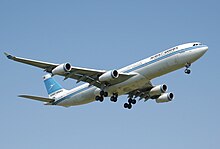 |
| A340-500/600 | 14 wheels [1x2]+[3x4] |  |  |  |
| A350-1000 | 14 wheels [1x2]+[2x6] |  |  |  |
| A380 | 22 wheels [1x2]+[2x4+2x6] |  |  |  |
| Aircraft | Wheels and Configuration | Nose section | Center section | Example |
|---|---|---|---|---|
| 717 , 727 , 737 | 6 wheels [1x2]+[2x2] |  |  |  |
| 747 | 18 wheels [1x2]+[4x4] |  |  |  |
| 707 , 720 , 757 , 767 , 787 | 10 wheels [1x2]+[2x4] |  |  |  |
| 777 | 14 wheels [1x2]+[2x6] |  |  |  |
| B-52 Stratofortress | 8 main wheels plus 2 outrigger wheels [2x2]+[2x2] |  |  |  |

Excavators are heavy construction equipment consisting of a boom, dipper, bucket and cab on a rotating platform known as the "house". The house sits atop an undercarriage with tracks or wheels. They are a natural progression from the steam shovels and often mistakenly called power shovels. All movement and functions of a hydraulic excavator are accomplished through the use of hydraulic fluid, with hydraulic cylinders and hydraulic motors. Due to the linear actuation of hydraulic cylinders, their mode of operation is fundamentally different from cable-operated excavators which use winches and steel ropes to accomplish the movements.

Landing gear is the undercarriage of an aircraft or spacecraft that is used for takeoff or landing. For aircraft it is generally needed for both. It was also formerly called alighting gear by some manufacturers, such as the Glenn L. Martin Company. For aircraft, Stinton makes the terminology distinction undercarriage (British) = landing gear (US).
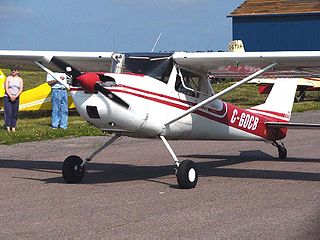
Conventional landing gear, or tailwheel-type landing gear, is an aircraft undercarriage consisting of two main wheels forward of the center of gravity and a small wheel or skid to support the tail. The term taildragger is also used, although some argue it should apply only to those aircraft with a tailskid rather than a wheel.

Tricycle gear is a type of aircraft undercarriage, or landing gear, arranged in a tricycle fashion. The tricycle arrangement has a single nose wheel in the front, and two or more main wheels slightly aft of the center of gravity. Tricycle gear aircraft are the easiest for takeoff, landing and taxiing, and consequently the configuration is the most widely used on aircraft.

The Mil Mi-10, given the product number izdeliye 60, is a Soviet military transport helicopter of flying crane configuration, developed from the Mi-6, entering service in 1963. While most versions had been retired by 2009, the short-legged Mi-10K was still in service as of 2014.
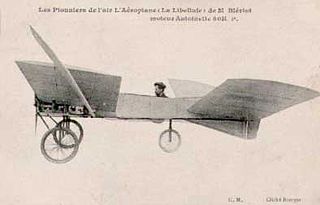
The Blériot VI "Libellule" ("Dragonfly"), was built in 1907 and was one of the series of experimental aircraft built by Louis Blériot which eventually led to the Blériot XI aircraft in which he made the first flight across the English Channel.

The Hanriot HD.2 was a biplane floatplane fighter aircraft produced in France during the First World War that was used after the war for testing the use of aircraft from warships.

The Blackburn Type I was a single-engine civil two-seat monoplane built in the United Kingdom in 1913. Three were produced and used for flying demonstrations and training including seaplane pilotage.
The Bristol Type 6 T.T.A was a British two-seat, twin-engine biplane, designed in 1915 as a defence fighter. Two prototypes were built, but the T.T.A. did not go into production.

The Handley Page Type D or H.P.4 was a single-seat, single-engined tractor monoplane, the first Handley Page design to fly for more than a few hops. Only one was built.
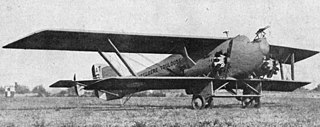
The Latécoère 6 was a French four-engined biplane bomber of the early 1920s. It was of advanced all-metal construction and probably the first aircraft to use geodetic construction. Only one was built.

The Praga E-210 was a four-seat, twin-engined touring aircraft built in Czechoslovakia in the late 1930s. It had an unusual pusher configuration. Its tail unit and undercarriage were modified significantly before World War II and after the war a more powerful version designated E-211 was flown.

The Slingsby Type 51 Dart is a single seat competition glider designed in the early 1960s, initially as a 15 m span Standard Class aircraft but evolved into an Open Class, 17 m sailplane. It was the last Slingsby sailplane to be mostly constructed of wood.

A glider or sailplane is a type of glider aircraft used in the leisure activity and sport of gliding. This unpowered aircraft can use naturally occurring currents of rising air in the atmosphere to gain altitude. Sailplanes are aerodynamically streamlined and so can fly a significant distance forward for a small decrease in altitude.

The Gwinn Aircar was a single-engined biplane with a cabin for two, designed in the US as a safe and simple private aircraft. Lacking a rudder, it had several unusual control features as well as an early tricycle undercarriage. Development was abandoned after a crash in 1938.
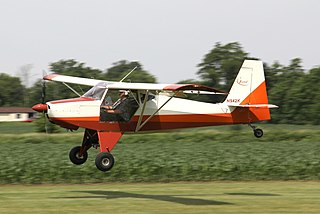
The Just Escapade is a single-engine, high-wing light aircraft, seating two in side-by-side configuration. It was jointly developed in the United States and the United Kingdom in the early 2000s and by 2010 some 145 Escapades and its "bush plane" variant, the Highlander, had been built and many more kits sold.
The Bonomi BS.22 Alzavola was a training motor glider, intended to acquaint capable glider pilots with the characteristics of powered aircraft. The sole example was designed and built in Italy in the mid-1930s.
Undercarriage is the part of a moving vehicle that is underneath the main body of the vehicle. The term originally applied to this part of a horse-drawn carriage, and usage has since broadened to include:

The Potez VIII was a French training aircraft which first flew in 1920. Originally it had a very unusual vertical inline engine and a four-wheeled undercarriage, though the production version was more conventional.

The Hydroaéroplane Caudron-Fabre, (Caudron-Fabre), was a French amphibious seaplane that competed in the 1912 Monaco event. It was one of the first true amphibians, able to take-off from water and touch down on land.